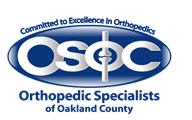
ARTHRITIS TREATMENT
Once arthritis sets in there is no way to reverse the damage that is done. Treatment can range from things as simple as exercise to as involved as injections and medications.
Most patients are given an overall program that includes a variety of treatment options. The goals of treatment are therefore to decrease the patient's discomfort, increase the patient's function, and to hopefully protect the joints from further damage. Our doctors believe that a crucial part of the treatment plan is to educate the patient regarding their condition so that they may be an integral part of the treatment plan.
Non-operative Treatment
Surgery for Arthritis
- Weight loss
Most patients don't understand that we can apply 6-8 times our body weight across our hips and knees with most every day activities. Therefore weight reduction is a crucial part of treating the pain and disability associated with arthritis. - Activity modifications
Avoiding high impact activities such as running, jumping and excessive climbing can significantly decrease the symptoms of arthritis. - Assistive devices such as cane or walker
Using a cane in the opposite hand can help decrease the load across the opposite hip by as much as 50 %.
![]() Medications
Medications
Medications
There are many medications available for the treatment of arthritis. Some of these are effective and others are nothing more than a gimmick. Unfortunately there are no medications which have been proven to reverse the disease
- Health Foods
These are "foods" that are available over the counter and without prescription.
BEWARE:
Because these substances are classified as foods they are not regulated by the FDA and usually make unfounded claims of curing arthritis. To date there are no medications which have been proven to regenerate a substantial amount of cartilage or reverse the damage caused by arthritis.
Compounds that have been shown to decrease pain and possibly protect our joints include Glucosamine Glycan and Chondroitin Sulfate.
- Anti-Inflammatory Medications
These include Ibuprofen, Naproxen, Celebrex, and others.
These medications work by decreasing the inflammation associated with arthritis. If effective, these medications can significantly decrease the pain associated with this disease. Unfortunately these medications have some serious side effects and patients should consult with their doctor before taking them.
![]() Injections
Injections
Injections
- There are two types of injections which are routinely used.
- Cortisone (more info)
Cortisone helps to decrease the inflammation associated with arthritis. This is usually injected directly into the joint and can provide many weeks of pain relief. This is not a permanent fix for the disease. Cortisone is used to temporarily relief one's symptoms. There are some side effects to these injections so make sure you discuss this with your doctor. -
What are Steroids?
Corticosteroids are a class of medications that are related to cortisone. Cortisone is a naturally occurring corticosteroid hormone produced by your adrenal glands.
Where are Steroids (Cortisone) Injected?
Steroids can be injected directly into the joints (intra-articular) or around the joints (peri-articular) or tendons.
How do Steroid (Cortisone) Injections Work?
After injection, corticosteroids work to reduce inflammation (heat, redness, swelling, & pain) in and around the joint. As a result you should feel less pain, swelling, stiffness and warmth and be able to function a little easier.
Why are Steroids (Cortisone) Injected Locally?
A steroid injection into or around the joint is an effective way to reduce inflammation in or around a single joint. The goal is to deliver the medication directly to the site where it is needed aiming to reduce the need for systemic treatment (pills).
What types of Steroids (Cortisone) are available for injection?
There are a few different varieties of steroids available for injection. The choice will likely depend on the preference of the treating physician. There is no available evidence that one type of steroid is significantly better than another. The types of steroids available are as follows:
Generic Name
Trade Name
Dose Range Methylprednisolone Solumedrol® 10 – 120 mg Triamcinolone Acetonide Kenalog® 10 – 80 mg Betamethasone Celestone Soluspan® 1 – 12 mg What types of Patients can receive Steroid (Cortisone) Injections?
Steroid injections are useful for many types of arthritic conditions. Local steroid injections can be valuable treatment for patients with inflammatory types of arthritis such as rheumatoid arthritis, psoriatic arthritis, gout, and lupus. Similarly, patients with osteoarthritis often derive benefit from steroid injections. Finally, local steroid injections can be safely used for the treatment of conditions such as tendonitis, bursitis, and tendon nodules.
How is a Steroid (Cortisone) Injection given?
A steroid injection into a joint or around a joint is much like an injection into the arm. Most injections are safely and routinely performed in a physician’s office. For joints in the spine or hip, injections are usually given by a radiologist under x-ray or ultrasound guidance. Local anesthetic is sometimes used prior to the injection or can be mixed with the steroid and injected directly into the joint to give immediate relief.
Does a Steroid (Cortisone) Injection Hurt?
In the hands of a skilled physician, the injections are relatively comfortable and as pain free as a simple blood test or injection into the muscle in the arm.
How long does it take for a Steroid (Cortisone) Injection to Work and how long will it Last?
Most injections typically take 24-48 hours to take full effect. If local anesthetic was given with the steroid injection, you may feel improvement relatively quickly. The duration of improvement varies. Some patients report months of relief whereas others find only a few days of relief.
If the first Steroid (Cortisone) Injection doesn’t work, can I try a second Injection?
In general, most patients, if they are going to respond, will respond after the first injection. Patients who have gained no symptom relief or functional benefit from two injections should probably not continue with repeat injections as the likelihood of improvement is small.
How often can I have repeat Steroid (Cortisone) Injections?
If a significant benefit is achieved after the first injection then an argument can be made for a repeat injection. There is some controversy that too many injections may weaken tendons, ligaments, and accelerate the loss of cartilage but other studies have found that injections can slow joint damage and help preserve the joint. As a general rule a reasonable approach is to limit the frequency of injections to 3-4 for a single joint per year.
Who should NOT receive Steroid (Cortisone) Injections?
Patients who should not receive an injection include those who have had a previous serious allergic reaction to a corticosteroid and those with an infection in the joint or in the skin or soft-tissues overlying the joint.
What should I feel after a Steroid (Cortisone) Injection?
If local anesthetic was injected with the steroid your pain may be improved over the few hours after the injection. Otherwise, it is normal to feel a transient increase in discomfort in the joint which should resolve within 24 hours. You can treat this discomfort by applying a cold pack such as a gel pack, bag of frozen vegetables, or crushed ice in a bag or by using medications such as Acetaminophen (Tylenol®) or Non-Steroidal Anti-Inflammatory Drugs (Check with your doctor).
What should I do after a Steroid (Cortisone) Injection?
If possible, it is best to rest the joint for 24-48 hours. Studies have shown this may improve the effect of the injection.
What are the possible side-effects of a Steroid (Cortisone) Injection?
Most joint injections result in no side-effects. Side-effects which rarely occur include: injury to the joint or tendon, loss of the fat layer below the skin, loss of skin pigmentation (vitiligo), calcification around the joint, and joint Infection (see below). The joint may ‘flare-up’ transiently after an injection. Systemic effects may occur due to absorption of some of the steroid from the joint.
When Should I call my Physician or seek Medical Attention?
If the injected joint becomes very painful, red, or swollen seek medical attention immediately as the joint may be infected. As your doctor has explained, one of the very rare (1 in 15,000) risks of a joint injection is infection. If the joint is infected it is very important to seek medical attention as soon as possible. However, the most common cause of these symptoms is a reaction to the injected steroid (“steroid flare”) which occurs in 2 to 5% of patients. A “steroid flare” usually begins 6-12 hours after the injection and may last for 2-3 days. Regardless of the cause, it is important to see a physician with these symptoms.
Are Steroid (Cortisone) Injections safe in Pregnancy?
It is generally advisable to avoid all medications during pregnancy and while you are trying to become pregnant. However, local steroid injections are believed to be one of the safer treatments for arthritis during pregnancy.
Clcik here for full article on Steriod (Cortisione) injections
- Cortisone (more info)
-
- Hyaluronic Acid (Commonly known as chicken injections)
Chicken Shots? Rooster comb injections is the description commonly used to describe the use of artificial synovial fluid injected into the joint to ease the pain and stiffness of arthritis.
The modern injections are all manufactured in a lab controlled biochemical process but the original versions were extracted from the combs of roosters and the name has stuck.
These are injections which are given into the knee once a week over three to five weeks. Hyaluronic acid is normally found in our joints and serves as a lubricant. This substance is available for injection and is showing promising results. Again this is a temporary treatment that may provide up to 6 months of pain relief.
- Hyaluronic Acid (Commonly known as chicken injections)
Surgery for Arthritis
Click above to learn how surgery can eliminate the pain and disability of arthritis.



